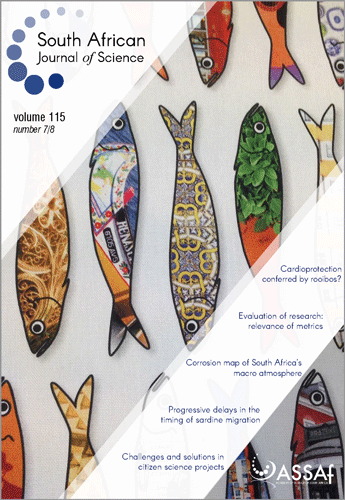Corrosion map of South Africa’s macro atmosphere
DOI:
https://doi.org/10.17159/sajs.2019/4901Keywords:
atmospheric, inland, coastal, mild steelAbstract
The first atmospheric corrosion map of South Africa, produced by Callaghan in 1991, has become outdated, because it primarily focuses on the corrosivity of coastal environments, with little differentiation given concerning South Africa’s inland locations. To address this problem, a study was undertaken to develop a new corrosion map of the country, with the emphasis placed on providing greater detail concerning South Africa’s inland regions. Here we present this new corrosion map of South Africa’s macro atmosphere, based on 12-month corrosion rates of mild steel at more than 100 sites throughout the country. Assimilations and statistical analyses of the data (published, unpublished and new) show that the variability in the corrosion rate of mild steel decreases significantly moving inland. Accordingly, the average first-year corrosion rate of mild steel at the inland sites (at all corrosion monitoring spots located more than 30 km away from the ocean) measured 21±12 μm/a [95% CI: 18–23 μm/a]. The minimum inland figure was about 1.3 μm/a (recorded at Droërivier in the Central Karoo) and the maxima were approximately 51 μm/a and 50 μm/a in the industrial hearts of Germiston (Gauteng) and Sasolburg (Free State), respectively. The variability in the corrosion rate of mild steel also decreased by as much as 80% between 150 m and 1000 m from the coastline. Moreover, the impact of changing altitude on the corrosivity of the environment was confirmed, particularly along the coastal regions.
Significance:
- A new corrosion map of South Africa’s inland and coastal regions is presented.
- The map facilitates the identification of South Africa’s least to most corrosive environments; enabling the selection of more appropriate corrosion protection solutions for general, business, mining and industrial installations.
- In identifying South Africa’s least corrosive areas, the use of more environmentally friendly corrosion protection procedures is potentially encouraged.
Published
Issue
Section
License

All articles are published under a Creative Commons Attribution 4.0 International Licence
Copyright is retained by the authors. Readers are welcome to reproduce, share and adapt the content without permission provided the source is attributed.
Disclaimer: The publisher and editors accept no responsibility for statements made by the authors
How to Cite
- Abstract 1636
- PDF 6343
- EPUB 206
- XML 428












.png)